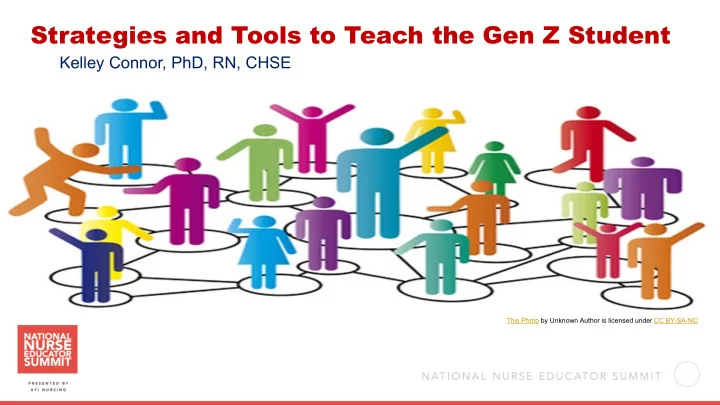

Strategies and Tools to Teach the Gen Z Student Kelley Connor, PhD, RN, CHSE This Photo by Unknown Author is licensed under CC BY-SA This Photo by Unknown Author is licensed under CC BY-SA-NC
Objectives Explain the defining characteristics of Gen Z students Create interactive lesson plans to teach nursing concepts Provide an example of an electronic tool that supports interactive learning This Photo by Unknown Author is licensed under CC BY-SA 2
Defining Characteristics of Generation Z Students As a small group, please list 2-3 defining events and 2-3 defining characteristics for each generation . Silent Baby Generation Millennials Generation Z Generation Boomer X (Born prior (Born 1945- (Born 1965- (Born 1981- (Born 1997-TBD) to 1945) 1964) 1980) 1996) Defining Great Depression (Economic events Uncertainty) WWII Defining Loyalty character- Work is a privilege istics Avoid waste 3
Generation Z This Photo by Unknown Author is licensed under CC BY-SA 4
Generation Z Students Defining Events Defining Characteristics ― 9/11 Terrorist attacks (no collective ― World has never been safe memory of attacks) ― Value individual space and projects more ― Great Recession than millennials ― School violence common ― Independent learners (YouTube as teacher) ― True Digital Natives ― Expect instant and exceptional technology (but they are realistic) ― Online communication has included voice, video, and emotions. They want more than just text This Photo by Unknown Author is licensed under CC BY 5
So, what next? 6
Engaging Generation Z Cantrell & Farer (2019) studied millennial students and found they are physically present in class but mentally absent, want respect from engaged professors, and they want more than surface learning. Barnes and Noble College (n.d.) 7
Classroom Engagement Strategies Frequent low-stakes testing Group Test ― High-stakes tests in nursing ― Group test/Group grade ― Use low-stakes tests prior to class ― Individual test/Group test (up to 10 point gain) • Learning Management System quizzes that students may take multiple times (*) Remind Content Announcements • Pre-class quizzes prior over reading (Remind.com) Socratic Questioning Muddiest Point Paper (1-minute paper) Reverse Socratic Questioning First Five Minutes (to socialize) Video selfie (doing homework) Nametag facts 8
What’s right and what’s wrong? Student’s select a pop-culture representation of a health related issue. Students must explain what they is accurate/inaccurate and why. Students should explain what they expect to happen next. Examples: ― Births from TV shows or movies ― Health conditions from shows like House or Grey’s anatomy ― Professional healthcare roles from TV shows or movies 9
Students as Teachers Twist on a case study Present students with a realistic case story and relevant documents/props Give students 15 minutes to outline 2-3 GBS Scenario: concerns with rationale, 2-3 risks for the patient, and what they want to happen for Baby Girl Newcourt is a 38 and 2/7 week the rest of their shift 2800 gm (6 lbs 3 oz) infant who was born 6 hours ago…. After 15 minutes, students present their case to the instructor Unfolding case study for informatics: Select a health information app and evaluate for use in a patient population, usability, and create an implementation plan. 10
Feel the Music 11
Think…Pair…Share Consider your educational content. What could you do to incorporate interactive activities? (60 seconds) Create a brief lesson plan (to remember later). Share with your neighbor. (60 seconds) This Photo by Unknown Author is licensed under CC BY-NC-ND 12
Connecting through worked examples https://youtu.be/cYKHeqrgRgo Providing students with worked examples (expert modeling) Providing students with good examples and guided facilitation Use recording capabilities through simulation center (always get consents!) Facilitate discussion with Socratic questioning or Debriefing model of your choice 13
Synchronous Online Space Class meetings Online office hours Group presentations (can be recorded so other groups can watch later) Module (or assignment) introductions Zoom https://zoom.us/ YouTube events Adobe Connect Others? 14
Nearpod • Create interactive presentations embedded with learning activities • Uploaded from previous Powerpoint presentationsPresentations can be student-paced or live • https://nearpod.com/
Nearpod: Options
Nearpod: Options
Class Quizzes: Socrative
Class Quizzes: Kahoot 19
20
Interactive Tool Over the next 60 seconds, share with your neighbor 1 interactive tool you want to try in the classroom. This Photo by Unknown Author is licensed under CC BY-SA 21
Teaching Generation Z • Foster independent learning • Incorporate multiple modes of learning • Use technology This Photo by Unknown Author is licensed under CC BY-NC 22
23 This Photo by Unknown Author is licensed under CC BY-NC
This Photo by Unknown Author is licensed under CC BY-NC-ND 24
References Barnes & Noble College. (n.d.). Getting to know generation z: Exploring middle and high schoolers’ expectations for higher education. Retrieved from https://www.bncollege.com/wp-content/uploads/2018/09/Gen-Z-Report.pdf Cantrell, M.A., & Farer, D. (2019). Millennial nursing students’ experiences in a traditional classroom setting. Journal of Nursing Education, 1, 27-32. doi:10.3928/01484834-20190103-05 Diliberto-Macaluso, K., & Hughes, A. (2016). The Use of Mobile Apps to Enhance Student Learning in Introduction to Psychology. Teaching of Psychology , 43, 48-52. doi:10.1177/0098628315620880 Yee, K. (2018, April 10) Interactive techniques. Retrieved from https://www.usf.edu/atle/documents/handout-interactive-techniques.pdf 25
Recommend
More recommend